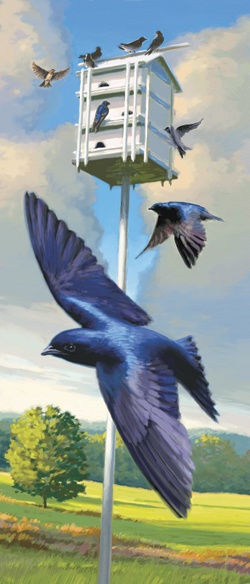Faint but familiar, the chirrups trilled from somewhere high above our ancient live oaks. Bent over a bed of straggly salvias in our yard last spring, I stopped trimming and listened intently. More chirps! Dropping my scissors, I dashed to the edge of a stand of trees and peered into the dusky evening sky.
Were Purple Martins finally about to move into the three-story white birdhouse we’d put up and watched over so faithfully?
I held my breath. A martin—glossy blue-black and fork tailed—soared around the aluminum-sided house, set high on a sturdy pole and featuring six compartments, or rooms. Then he landed on a porch and peered curiously inside one of the compartments. “Yes, yes, YES!” I squealed excitedly, jumping, dancing and waving my arms all at once.
OK, maybe I’m a little weird. But I’m not the only one who goes berserk at the sight of a Purple Martin. Every January and February, folks who call themselves “PM landlords” scan the skies daily and act nutty, too, when they spot their first martins of the season. As yet, however, my husband, James, and I are not official landlords because we don’t have tenants in our house, but hopefully that will change this spring.
East of the Rocky Mountains, Purple Martins (Progne subis)—the largest members of the swallow family—almost exclusively nest in houses and gourds supplied by humans. It’s believed their reliance on human-built housing dates back to when Native Americans hung hollow gourds near villages. The fiercely territorial martins kept scavenging animals away from tribes’ crops and meats. Likewise, the martins’ close proximity to people discouraged predators from raiding their nests. (Farther west, the species typically nests in natural cavities in trees and saguaro cacti.)
Contrary to popular belief, martins that show up first are not “scouts,” but simply the first to migrate north from their South American winter homes, primarily in Brazil. Adult martins typically return to the same housing every year if they’ve been successful in raising their babies there. Last year’s youngsters, called “subadults,” migrate north from South America four to six weeks after adults do so. New landlords like us have the best chance of attracting subadults, who need their own place.
As a teen in Corpus Christi, I always loved to hear the cheerful chortling of our neighbors’ martins. More recently, my interest in the species grew whenever I’d spy some at a martin house in our Blanco neighborhood. Entertaining to watch, Purple Martins also prey on flying insects, though not as many mosquitoes as once presumed. Mosquitoes compose only 3 percent or less of martins’ diet. They prefer larger insects—wasps, flies, dragonflies, moths and beetles—caught way up in the air (mosquitoes hover near the ground).
Soon after arrival at their home for the season, martin romancing starts. The female chooses her mate based mostly on whether she likes the compartment he’s chosen. Next, the couple builds a nest of mud, twigs, straw and pine needles, topped with a layer of green leaves. When the offspring fledge, martins within the same colony turn out for the big social event, creating quite a ruckus.
In July, after the breeding season, thousands of martins gather in huge communal roosts in trees and under bridges before returning to South America. Their numbers can be so dense that they show up on Doppler radar when in flight!
As for our new martin house, despite some initial poking around, no one moved in last spring. Yes, James and I were disappointed. But we also understand that establishing a new colony takes time, sometimes several years. So we don’t plan to give up. Like bona fide PM landlords across Texas, we’ll put up our house again this month, then watch and listen …
I can’t wait to do the happy dance again!
——————-
Sheryl Smith-Rodgers wrote about salvias in the August issue of Texas Co-op Power.


